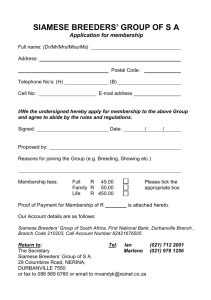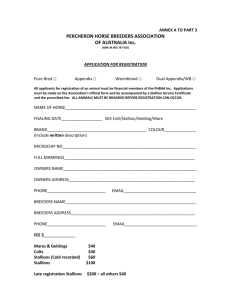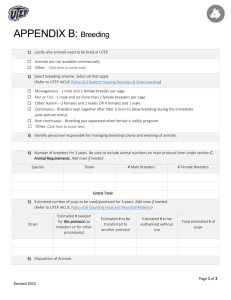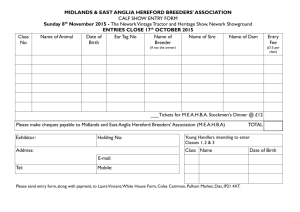S - Central Wool Development Board
advertisement
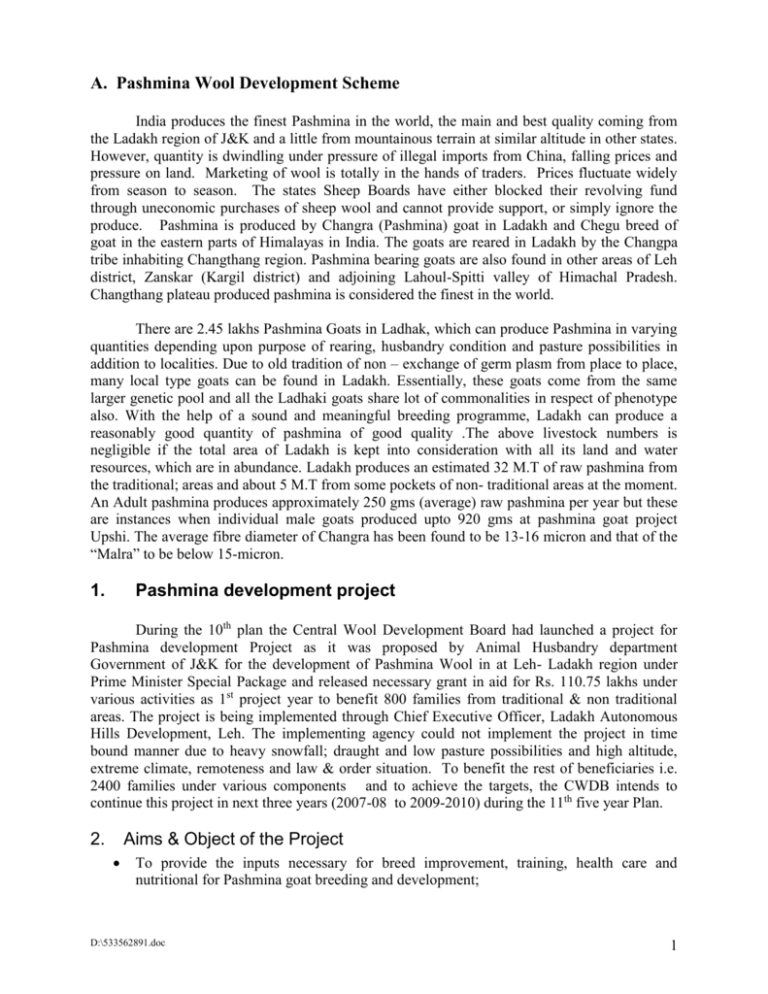
A. Pashmina Wool Development Scheme India produces the finest Pashmina in the world, the main and best quality coming from the Ladakh region of J&K and a little from mountainous terrain at similar altitude in other states. However, quantity is dwindling under pressure of illegal imports from China, falling prices and pressure on land. Marketing of wool is totally in the hands of traders. Prices fluctuate widely from season to season. The states Sheep Boards have either blocked their revolving fund through uneconomic purchases of sheep wool and cannot provide support, or simply ignore the produce. Pashmina is produced by Changra (Pashmina) goat in Ladakh and Chegu breed of goat in the eastern parts of Himalayas in India. The goats are reared in Ladakh by the Changpa tribe inhabiting Changthang region. Pashmina bearing goats are also found in other areas of Leh district, Zanskar (Kargil district) and adjoining Lahoul-Spitti valley of Himachal Pradesh. Changthang plateau produced pashmina is considered the finest in the world. There are 2.45 lakhs Pashmina Goats in Ladhak, which can produce Pashmina in varying quantities depending upon purpose of rearing, husbandry condition and pasture possibilities in addition to localities. Due to old tradition of non – exchange of germ plasm from place to place, many local type goats can be found in Ladakh. Essentially, these goats come from the same larger genetic pool and all the Ladhaki goats share lot of commonalities in respect of phenotype also. With the help of a sound and meaningful breeding programme, Ladakh can produce a reasonably good quantity of pashmina of good quality .The above livestock numbers is negligible if the total area of Ladakh is kept into consideration with all its land and water resources, which are in abundance. Ladakh produces an estimated 32 M.T of raw pashmina from the traditional; areas and about 5 M.T from some pockets of non- traditional areas at the moment. An Adult pashmina produces approximately 250 gms (average) raw pashmina per year but these are instances when individual male goats produced upto 920 gms at pashmina goat project Upshi. The average fibre diameter of Changra has been found to be 13-16 micron and that of the “Malra” to be below 15-micron. 1. Pashmina development project During the 10th plan the Central Wool Development Board had launched a project for Pashmina development Project as it was proposed by Animal Husbandry department Government of J&K for the development of Pashmina Wool in at Leh- Ladakh region under Prime Minister Special Package and released necessary grant in aid for Rs. 110.75 lakhs under various activities as 1st project year to benefit 800 families from traditional & non traditional areas. The project is being implemented through Chief Executive Officer, Ladakh Autonomous Hills Development, Leh. The implementing agency could not implement the project in time bound manner due to heavy snowfall; draught and low pasture possibilities and high altitude, extreme climate, remoteness and law & order situation. To benefit the rest of beneficiaries i.e. 2400 families under various components and to achieve the targets, the CWDB intends to continue this project in next three years (2007-08 to 2009-2010) during the 11th five year Plan. 2. Aims & Object of the Project To provide the inputs necessary for breed improvement, training, health care and nutritional for Pashmina goat breeding and development; D:\533562891.doc 1 3 Stabilize marketing arrangements through cooperatives/federations of Pashmina wool producers; and To establish means for the early stages of processing within the region and its operation by wool producers’ federations for first stage value addition. To increase the income from wool of the goat rearers and sustain their interest in this activity as a reliable means of livelihood. To increase yield of Pashmina to 50 MT To organize the Pashmina producers into federation or cooperatives on the lines of the successful milk federation of NDDB To streamline marketing systems for raw and partially processed Pashmina with a view to obtain higher incomes for the Pashmina woolgrowers. Components The components wise activities to be taken up in next three years are as under Buck Exchange Programme: The idea behind the scheme will be to bring about a high level of heterogeneity in the goat flocks to reduce the chances and also the negative impact of inbreeding as the breeders, especially the nomadic breeders possessing good livestock number, traditionally graze their livestock separately and keep one buck in one flock for many years increasing chances of inbreeding in the respective flocks. The heterogeneity thus brought about, will surely improve chances of enhanced pashmina production from individual goats. Rs. 500-1000 shall be paid to each participating breeders who are ready to part with their bucks and accept fresh/new bucks arranged by Sheep Husbandry Department. A tentative 500 breeders shall be brought under the ambit of the scheme each year for which 500 bucks (Five month to three years old) shall needed for exchange. Rs. 3.75 lacs @ average Rs. 750/- animal shall be required for payment of incentives on 500 bucks, their transportation to the target beneficiaries and also for miscellaneous expanses on their feed, labour and T.A. /D.A. of staff each year i.e. Rs. 10.50 lacs for 3 years. Distribution of high quality pashmina bucks in non-traditional areas to enhance pashmina production. 300 quality bucks to be purchased and transported to the target areas, every year, for free distribution to breeders holding, at least 30 breedable Does. The breeder will have to execute an agreement with the Govt. to the effect that the buck will remain in common property for at least 4 years from the date of issue after which the breeder will own it completely. The idea will be to bring about a qualitative change in the goat population of the breeder for increased pashmina production. Moreover, the breeders in the non-traditional pashmina producing regions graze their livestock together under roster provision for shepherding. The buck will bring about change in the village flock also. D:\533562891.doc 2 Training of formation of Breeders Association (Gilds) or village Pashmina Cooperative Societies: The de-hairing project sanctioned by the Central Wool Development Board, Govt. of India, Ministry of Textiles has provisions for assistance in setting up of pashmina growers cooperatives at the District level and also at the village and block levels. The people have to be highly sensitized and educated by organizing these camps in collaboration with the cooperative department at Leh. 20 training camps will be organized in the first year for the purpose, as there are 22 small village level cooperative societies in Changthang at the moment. Rs. 2.50 lac is proposed to be spent on the arrangements for each camp to motivate and sensitize the members of the 22 multipurpose small cooperative societies. Establishment of Fodder BankThe department has established feed banks in Changthang where more than 3000 Quintals of Feed/Barely is stored every year for supply to breeders during crisis period of winter. It has been observed over the year that the nomads are not able to pay the landed cost of feed. Hence the department had to arrange for subsidy for timely disposal of the feed stored at the feed banks. It is a fact that the transportation cost is very high in Ladakh as the nomadic hamlets are located for away from Leh. In all fairness, the transports need to be completely subsidized so that the nomads are able to lift the feed/fodder and save the livestock. We propose setting up of fodder banks in the pattern of feed banks for which a revolving fund shall be needed. This will be a crisis management mechanism and shall be in operation irrespective of calamity or no calamity as feed/fodder cannot be stored for long periods of time. Rs. 10.00 lacs shall be needed for purchases of approximately 1250 Qtls. Rs. 30.00 lacs is required for 3 years. The fodder banks are proposed to set up at Kharnak, Samad, Angkung (Sumdo), Korzok, Tegajung Deque Karluk, Phobrang and Kargium villages in Changthang. Training refreshers to Nomadic Breeders as Paramedics: The area of Changthang is spread over an area approximately of 22000 sq. km. The Changpas are migratory and remain in migration through out the years. The Govt. extension centers are located at particular stations. Although it is mandatory on the pat of the extension centers to remain in migration with the private breeders (nomads) yet it is practically difficult to do so. Hence, it is proposed to train some youth (nomadic and others) in the use of simple medicines and also other aspects of breeding and management of livestock so that their services are available to the nomadic communities every time. The Veterinary paramedic shall be provided with Vety. Kits and a continuous supply of medicines shall be ensured under health coverage schemes. Health Coverage: At least 10 essential vet. Medicines and 2 Vaccines i.e. against FMD and PPR (once a year) shall be procured in good quantity and some simple equipments e.g. syringes, needles, drenching guns, hoof cutters, gloves, sterilization sets, instrument sets etc. shall be procured for supply to the breeders and Veterinary paramedics, free of cost. An estimated No. of 1.00 lac pashmina goats are proposed to be treated under the scheme and an average Rs. 10/- is proposed to be spent per goat. D:\533562891.doc 3 Refresher Course to Inservice Candidates for 3 days/breeders camps: The work force of the department shall be imparted training in the latest advances in medicines, techniques of breeding and management etc and the breeder conferences/ camps shall also be organised in order to motivate the breeders to go for quality and quantity production of pashmina through adoption of scientific techniques. Four refresher courses for in-service candidates and 8 breeder camps for breeders shall be organized every year. A provision for Rs 2.30 Lacs per year has made for this activity. Fodder Development Fodder availability is the singly most important stumbling block for increased pashmina production. The nomadic areas, traditionally, do not produce grass for harvest and storage for winter use. In absence of stacked fodder grass during winter, livestock have to perish in the thousands at the time of calamities as a result of heavy snowfall during some winters. Three different sites will be selected to develop and grow fodder. The sites are proposed to be fenced, reclaimed and irrigation water is proposed to be arranged through drawing simple irrigation canals. One site shall be developed every year under the project. The recurring cost on account of purchase of seed/implements and other accessories shall be provided under the project and also by debit to the normal schemes of the department and other related departments in Leh. Rs. 7.40 lacs are proposed for 3 years for land development. Provision of Improved Pashmina Combs for Efficient Harvesting of Pashmina: This is a continuing scheme under BADP (China Border) under which the nomadic breeders provide an improved pashmina comb free of cost to the pashmina breeder to replace the obsolete wooden comb traditionally used. Although majority of the breeders have been covered under the scheme in Chagthang region yet the non-traditional areas need also to be brought under this scheme for which there is no provision of funding from the State sector or the BADP. Hence Rs. 6.00 lacs (2.00 lacs every Year) is proposed for the purpose. 1000 combs shall be distributed every year to the breeders @ Rs. 200/- per comb approximately. D:\533562891.doc 4 PASHMINA DEVELOPMENT PROJECT Project funded by: - Central Wool Development Board, Ministry of Textiles, Govt. of India, Jodhpur. Project Implementation by: - Animal Husbandry Department, Govt. of J.&K. through Ladakh Hill Development Council, Leh. Project period: - 3 years (2007-08 to 2009-2010) No. of Families to be covered: - 800 Families per Year. Total Cost of Project : Funding Pattern :- Rs. 127.50 lacs Rs. 100% grant by Central Wool Development Board The year wise physical & financial targets for 3 years project period (2007-08 to 2009-10) are as underRs. In Lakhs S. No. 1 2 3 4 5 6 7 8 9 Sanctioned Components Buck exchange programme for traditional Area (500 Number @ Rs. 750 per Buck) (In first year400 buck) Distribution of high quality pashmina bucks in non traditional area (300 number @ Rs.2000 per Buck) (In first year 200 buck) Training for formation of breeders Association (Guilds) or village pashmina cooperative societies Number of Camps- 10 camps per year @ Rs. 25,000/Numbers of Breeders –200 in each camp Establishment of fodder bank (3) Training to nomadic breeders as paramedics ( 1 Batch of 50 persons in a year) Health Coverage (One Lakhs Animals per year @ 10/- per animal) Refresher course to in service candidate/ breeders camps (2 courses for In service candidates- 70 workers per year) (6 camps for breeders per year- 50 breeders per camp) Fodder development (One site per year) Purchase of improved iron pashmina combs (1000 combs per year) Total Rs : D:\533562891.doc 1st Year 3.00 2nd year 3.75 3rd year Total 3.75 10.50 4.00 6.00 6.00 16.00 2.50 - - 2.50 10.00 10.00 10.00 30.00 6.00 6.00 6.00 18.00 10.00 10.00 10.00 30.00 2.30 2.30 2.30 6.90 - 3.70 3.70 2.20 2.00 2.00 6.20 40.00 43.75 43.75 127.50 7.40 5 Component-wise indicative financial implication for ‘Pashmina Wool Development Programme’ during the 11th Five Year Plan for Rs. 1.275 crore is as under : Activity Unit Funds required [Rs. in lakhs] 2007-08 2008-09 2009-10 2010-11 2011-12 Total - 0.030 0.0375 0.0375 - 0.1050 - 0.04 0.06 0.06 - 0.16 0.025 - - - - 0.025 0.066 0.134 0.10 - - 0.30 0.06 0.06 0.06 - - 0.18 One lakh animals per year @ Rs. 10/- per animal 7 Refresher course to in 2 courses for 70 service candidate/breeders workers per year camps and 6 camps for (2 courses for in service breeders year – 50 candidates – 70 workers per breeders per camp year) (6 camps for breeders year – 50 breeders per camp) 8 Fodder development One site per year - 0.10 0.10 0.10 - 0.30 - 0.023 0.023 0.023 - 0.069 - - 0.037 0.037 - 0.074 9 Purchase of improved iron 1000 combs per pashmina combs year - 0.022 0.020 0.020 - 0.062 0.151 0.409 0.4375 0.2775 - 1.275 Development of Pashmina in Traditional Areas 1 Buck exchange programme 500 number @ Rs. for traditional area (first 750 per Buck year 400 bucks) 2 Distribution of high quality 300 number @ Rs. pashmina bucks in non- 2000 per Buck per traditional area (First year year 200 bucks) 3 Training for formation of Number of camps breeders Associations – 20 per year [guilds] or village pashmina No. of breederscooperative societies (1st 200 in each camp year 10 camps) 4 Establishment of feed/ 3 fodder banks fodder banks 1000 Qtls. Feed & 1500 Qtls. Fodder 5 Training to nomadic 3 Batches of 50 breeders as paramedics persons in a year 6 Health Coverage Total D:\533562891.doc 6

